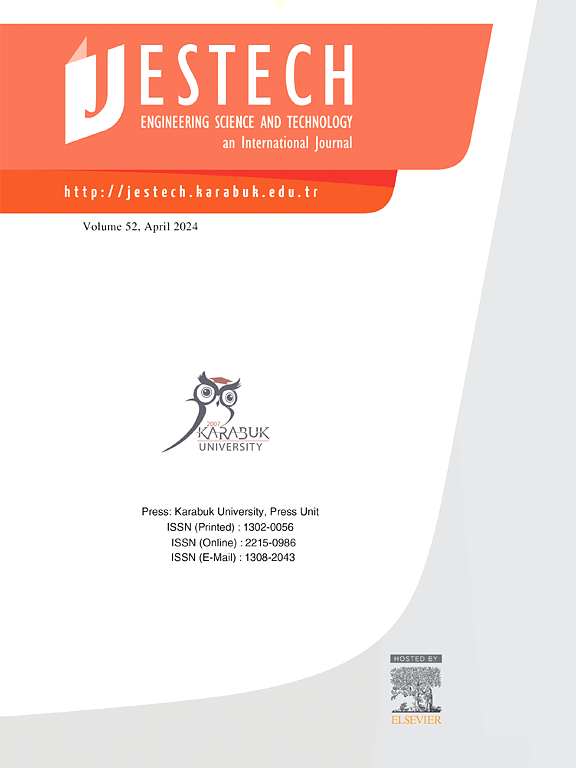State-of-the-art review of contact and friction analysis with a spherical hinge and structural stability research on horizontal rotating bridges
IF 5.1
2区 工程技术
Q1 ENGINEERING, MULTIDISCIPLINARY
Engineering Science and Technology-An International Journal-Jestech
Pub Date : 2025-01-01
DOI:10.1016/j.jestch.2024.101917
引用次数: 0
Abstract
Horizontal rotation is the most commonly used method for constructing rotating bridges. A spherical hinge is a critical component in a horizontal rotation system of bridges, and the hinge has a complex stress state that directly affects security and stability during rotation construction. This paper takes spherical hinge as the research object, and sorts out the logical relationship between the contact and frictional behavior of spherical hinges and the stability of rotary structures. It systematically summarizes the current research status on the mechanical behavior of spherical hinges in the contact and friction processes and the structural stability of horizontal rotating bridges. The contact problem of a spherical hinge is investigated in terms of elasticity mechanics and contact mechanics theory. Research studies that utilize mechanical analytical models to solve contact stress and numerical simulation methods to analyze contact problems are summarized. The vertical friction moment of the spherical hinge is obtained based on a weighing test, the intrinsic connection between the contact and friction forces during the rotation of the spherical hinge is explored, and the friction force model and calculated traction force during the process of horizontal rotation are discussed. Finally, the form of instability and the mechanism for overturning the resistance of the rotating structure are analyzed. Research on the unbalanced factor of the rotating system and the effect of external loads on the stability of the structural anti-overturning are also discussed. This paper summarizes the research studies on the contact and friction analysis and the structural stability of the horizontal rotating process of bridges to provide theoretical guidance for optimizing spherical hinges and constructing rotating bridges.
球面铰接触摩擦分析及水平旋转桥梁结构稳定性研究进展
水平旋转是建造旋转桥梁最常用的方法。球面铰是桥梁水平旋转体系中的关键部件,其受力状态复杂,直接影响桥梁旋转施工的安全性和稳定性。本文以球面铰为研究对象,梳理了球面铰的接触和摩擦行为与回转结构稳定性之间的逻辑关系。系统总结了球面铰在接触摩擦过程中的力学行为及水平旋转桥梁结构稳定性的研究现状。运用弹性力学和接触力学理论研究了球面铰的接触问题。综述了利用力学解析模型求解接触应力和数值模拟方法分析接触问题的研究进展。通过称重试验获得了球面铰的垂直摩擦力矩,探讨了球面铰旋转过程中接触力与摩擦力之间的内在联系,讨论了球面铰水平旋转过程中的摩擦力模型和计算的牵引力。最后,分析了旋转结构的失稳形式和倾覆阻力机理。研究了旋转系统的不平衡因素和外载荷对结构抗倾覆稳定性的影响。本文对桥梁水平旋转过程的接触摩擦分析和结构稳定性研究进行了总结,为优化球面铰和建造旋转桥梁提供理论指导。
本文章由计算机程序翻译,如有差异,请以英文原文为准。
求助全文
约1分钟内获得全文
求助全文
来源期刊

Engineering Science and Technology-An International Journal-Jestech
Materials Science-Electronic, Optical and Magnetic Materials
CiteScore
11.20
自引率
3.50%
发文量
153
审稿时长
22 days
期刊介绍:
Engineering Science and Technology, an International Journal (JESTECH) (formerly Technology), a peer-reviewed quarterly engineering journal, publishes both theoretical and experimental high quality papers of permanent interest, not previously published in journals, in the field of engineering and applied science which aims to promote the theory and practice of technology and engineering. In addition to peer-reviewed original research papers, the Editorial Board welcomes original research reports, state-of-the-art reviews and communications in the broadly defined field of engineering science and technology.
The scope of JESTECH includes a wide spectrum of subjects including:
-Electrical/Electronics and Computer Engineering (Biomedical Engineering and Instrumentation; Coding, Cryptography, and Information Protection; Communications, Networks, Mobile Computing and Distributed Systems; Compilers and Operating Systems; Computer Architecture, Parallel Processing, and Dependability; Computer Vision and Robotics; Control Theory; Electromagnetic Waves, Microwave Techniques and Antennas; Embedded Systems; Integrated Circuits, VLSI Design, Testing, and CAD; Microelectromechanical Systems; Microelectronics, and Electronic Devices and Circuits; Power, Energy and Energy Conversion Systems; Signal, Image, and Speech Processing)
-Mechanical and Civil Engineering (Automotive Technologies; Biomechanics; Construction Materials; Design and Manufacturing; Dynamics and Control; Energy Generation, Utilization, Conversion, and Storage; Fluid Mechanics and Hydraulics; Heat and Mass Transfer; Micro-Nano Sciences; Renewable and Sustainable Energy Technologies; Robotics and Mechatronics; Solid Mechanics and Structure; Thermal Sciences)
-Metallurgical and Materials Engineering (Advanced Materials Science; Biomaterials; Ceramic and Inorgnanic Materials; Electronic-Magnetic Materials; Energy and Environment; Materials Characterizastion; Metallurgy; Polymers and Nanocomposites)
 求助内容:
求助内容: 应助结果提醒方式:
应助结果提醒方式:


